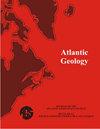The fossil flora and age of the Wamsutta red beds (Middle Pennsylvanian), Narragansett Basin, southeastern Massachusetts, USA and correlation with the Cumberland Group of the Maritime Provinces of Canada
IF 0.9
4区 地球科学
Q2 GEOLOGY
引用次数: 2
Abstract
New collections of plant macrofossils provide a precise Middle Pennsylvanian age for the lower Wamsutta Formation red beds of the Narragansett Basin, southeastern Massachusetts, USA. The Wamsutta assemblage indicates strong correlation with the Cumberland Group of the Maritimes Provinces of Canada, which was earlier considered to be of late Langsettian to early Duckmantian age. This correlation is supported by the presence in the Wamsutta Formation of the following plant-fossil species: Neuralethopteris schlehanii, Neuropteris obliqua, Senftenbergia plumosa, Calamites suckowii, Annularia asteris, Annularia cf. microphylla,Asterophyllites charaeformis, Asterophyllites grandis, Asterophyllites lindleyanus, Sphenophyllum cuneifolium, and Sphenopteris valida. Moreover, the new fossil flora resembles the Middle Pennsylvanian florules of western Europe, such as the Laveineopteris loshii Subzone. The new flora is especially similar to those of the Iberian Peninsula, where there is a complete succession of Carboniferous macrofloral zones, and this similarity confirms a late Langsettian or early Duckmantian age for the lower Wamsutta macroflora. The new collections of Wamsutta Formation plant fossils, along with a smaller existing collection, represent the oldest known macroflora in the Narragansett Basin.美国马萨诸塞州东南部纳拉甘塞特盆地Wamsutta红层化石区系和时代及其与加拿大沿海省份坎伯兰群的对比
新收集的植物宏观化石为美国马萨诸塞州东南部纳拉甘西特盆地下瓦姆苏塔组红层提供了精确的中宾夕法尼亚时代。Wamsutta组合与加拿大Maritimes省的Cumberland群具有很强的相关性,后者被认为是Langsettian晚期至Duckmantian早期。这种相关性得到了以下植物化石物种在Wamsutta地层中的存在的支持:neuroalethopteris schlehanii、Neuropteris obliqua、Senftenbergia plumosa、Calamites suckowii、Annularia asteris、Annularia cfmicrophylla、asterophylites charaformis、asterophylites grandis、asterophylites lindleyanus、Sphenophyllum cuneifolium和Sphenopteris valida。此外,新的化石区系类似于西欧的中宾夕法尼亚区系,如Laveineopteris loshii亚区。新的植物区系与伊比利亚半岛的植物区系特别相似,那里有完整的石炭纪大型植物区系,这种相似性证实了下瓦姆苏塔大型植物区系的Langsettian晚期或Duckmantian早期。新发现的Wamsutta组植物化石,以及现有的较小的植物化石,代表了纳拉甘西特盆地已知最古老的大型植物群。
本文章由计算机程序翻译,如有差异,请以英文原文为准。
求助全文
约1分钟内获得全文
求助全文
来源期刊

Atlantic Geology
GEOLOGY-
CiteScore
2.10
自引率
18.80%
发文量
0
审稿时长
>12 weeks
期刊介绍:
Atlantic Geology (originally Maritime Sediments, subsequently Maritime Sediments and Atlantic Geology) covers all aspects of the geology of the North Atlantic region. It publishes papers, notes, and discussions on original research and review papers, where appropriate to the regional geology.
 求助内容:
求助内容: 应助结果提醒方式:
应助结果提醒方式:


